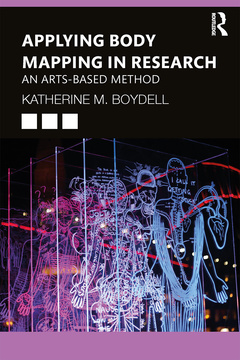Description
Applying Body Mapping in Research
An Arts-Based Method
Language: English
Subjects for Applying Body Mapping in Research:
Keywords
Body Mapping Process; Black Dog Institute; Mental health status; Body Mapping Exercise; Dissemination process; Knowledge Translation Approach; Arts-based research; Body Mapping; Young Man; Vulnerable identities; Public Engagement; Art Therapy; Arts Based Research; Researcher Field Notes; Combined Action Research; Smart Garments; Iterative Design Method; Complex Support; Cognitive Disability; Post-phenomenological Approach; Complex Trauma Histories; Australian National Disability Insurance Scheme; Arts Based Research Methods; Aboriginal Community Controlled Health Organisations; Complex Trauma; Kate’s Study; Aboriginal Researcher; Visual Content Analysis; Integrated Knowledge Translation
Publication date: 12-2020
· 15.6x23.4 cm · Paperback
Publication date: 12-2020
· 15.6x23.4 cm · Hardback
Description
/li>Contents
/li>Readership
/li>Biography
/li>
This book provides an overview of the innovative, arts-based research method of body mapping and offers a snapshot of the field.
The review of body mapping projects by Boydell et al. confirms the potential research and therapeutic benefits associated with body mapping. The book describes a series of body mapping research projects that focus on populations marginalised by disability, mental health status, and other vulnerable identities. Chapters focus on summarising the current state of the art and its application with marginalised groups; analytic strategies for body mapping; highlighting body mapping as a creation and a dissemination process; emerging body mapping techniques including web-based, virtual reality, and wearable technology applications; and measuring the impact of body maps on planning, practice, and behaviour. Contributors and editors include interdisciplinary experts from the fields of psychology, sociology, anthropology, and beyond.
Offering innovative ways of engaging in body mapping research, which result in real-world impact, this book is an essential resource for postgraduate students and researchers.
Foreword by Jane X. Solomon Introduction Chapter 1 – Applying body mapping to research with marginalised and vulnerable groups Chapter 2 – Mapping conversations: body maps as relational objects in groups and dialogues Chapter 3 – Representations of complex trauma: body maps as a narrative mosaic Chapter 4 – Body mapping in process: observing how participants represent experiences of anxiety Chapter 5 – The logistics of making and preserving body maps as research data Chapter 6 – Meaning-making and research rigour: approaches to the synthesis of multiple data sources in body mapping Chapter 7 – Development of a web-based body mapping application Chapter 8 – Body mapping and virtual reality Chapter 9 – Wearable technology and body mapping Chapter 10 – Audience response to the dissemination of body mapping research via installation art Chapter 11 – Real-world integration: body maps as a planning tool Concluding remarks: remembering the body
Katherine M. Boydell is Head of the AKT (Arts-Based Knowledge Translation) Lab at the Black Dog Institute and Director of Knowledge Translation, Sydney Partnership for Health Education Research and Enterprise, Australia.




